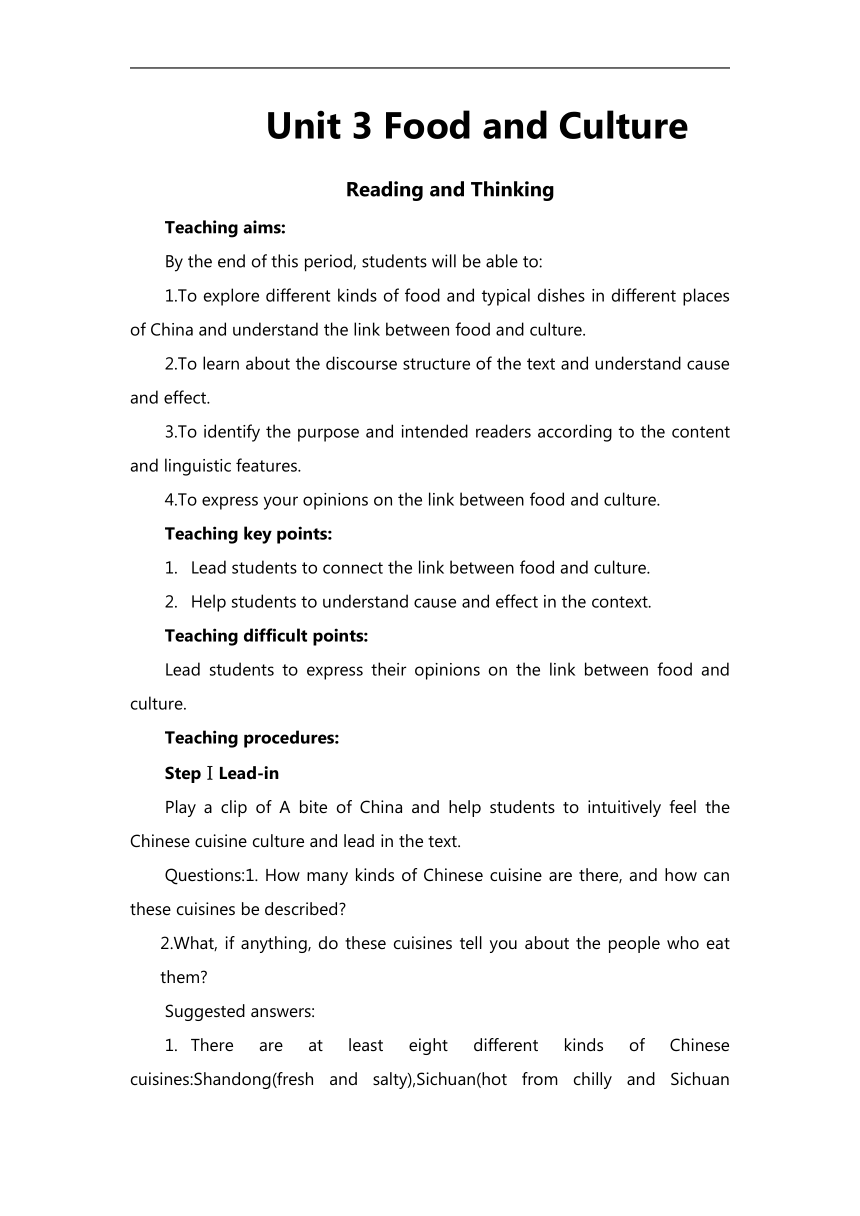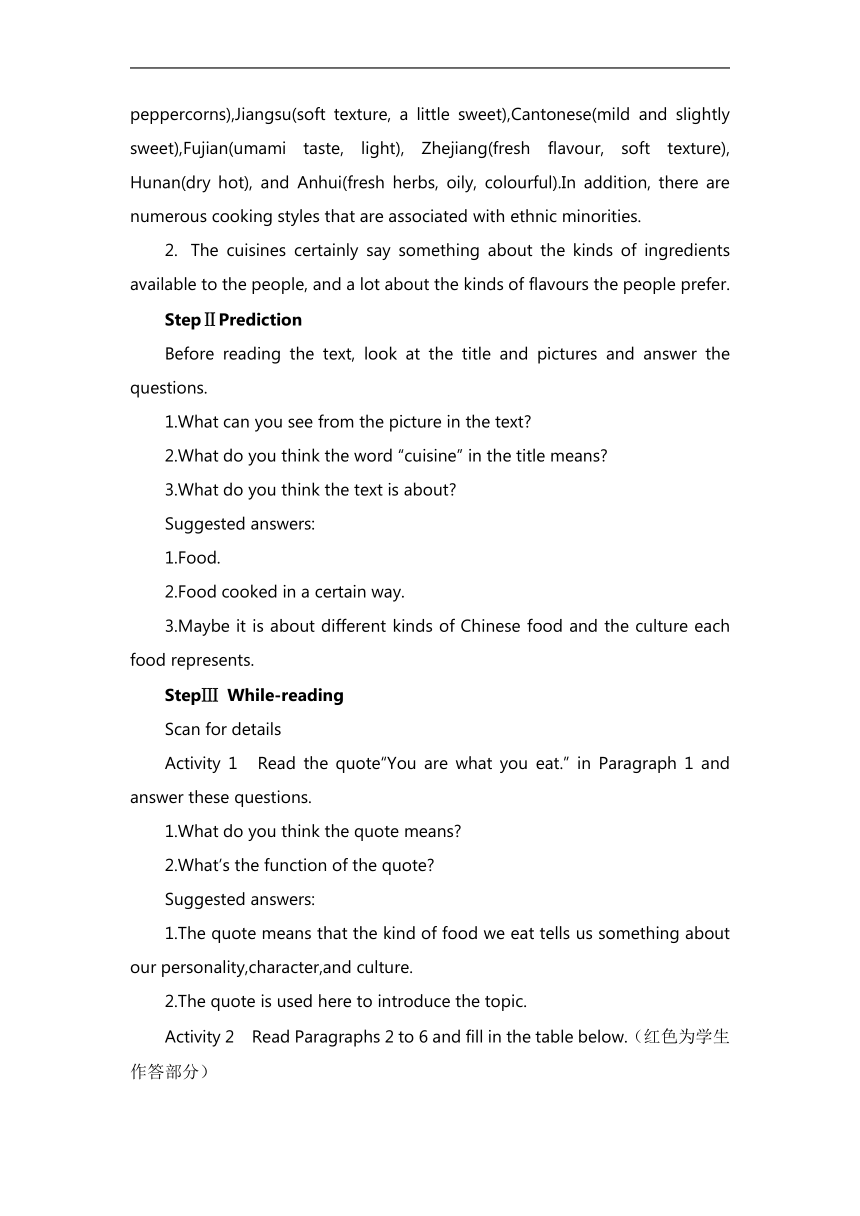人教版(2019) 选择性必修 第二册Unit 3 Food and Culture Reading and Thinking教案
文档属性
| 名称 | 人教版(2019) 选择性必修 第二册Unit 3 Food and Culture Reading and Thinking教案 |  | |
| 格式 | docx | ||
| 文件大小 | 411.2KB | ||
| 资源类型 | 教案 | ||
| 版本资源 | 人教版(2019) | ||
| 科目 | 英语 | ||
| 更新时间 | 2024-05-08 09:33:49 | ||
图片预览


文档简介
Unit 3 Food and Culture
Reading and Thinking
Teaching aims:
By the end of this period, students will be able to:
1.To explore different kinds of food and typical dishes in different places of China and understand the link between food and culture.
2.To learn about the discourse structure of the text and understand cause and effect.
3.To identify the purpose and intended readers according to the content and linguistic features.
4.To express your opinions on the link between food and culture.
Teaching key points:
Lead students to connect the link between food and culture.
Help students to understand cause and effect in the context.
Teaching difficult points:
Lead students to express their opinions on the link between food and culture.
Teaching procedures:
StepⅠLead-in
Play a clip of A bite of China and help students to intuitively feel the Chinese cuisine culture and lead in the text.
Questions:1. How many kinds of Chinese cuisine are there, and how can these cuisines be described
2.What, if anything, do these cuisines tell you about the people who eat them
Suggested answers:
There are at least eight different kinds of Chinese cuisines:Shandong(fresh and salty),Sichuan(hot from chilly and Sichuan peppercorns),Jiangsu(soft texture, a little sweet),Cantonese(mild and slightly sweet),Fujian(umami taste, light), Zhejiang(fresh flavour, soft texture), Hunan(dry hot), and Anhui(fresh herbs, oily, colourful).In addition, there are numerous cooking styles that are associated with ethnic minorities.
The cuisines certainly say something about the kinds of ingredients available to the people, and a lot about the kinds of flavours the people prefer.
StepⅡPrediction
Before reading the text, look at the title and pictures and answer the questions.
1.What can you see from the picture in the text
2.What do you think the word “cuisine” in the title means
3.What do you think the text is about
Suggested answers:
1.Food.
2.Food cooked in a certain way.
3.Maybe it is about different kinds of Chinese food and the culture each food represents.
StepⅢ While-reading
Scan for details
Activity 1 Read the quote“You are what you eat.” in Paragraph 1 and answer these questions.
1.What do you think the quote means
2.What’s the function of the quote
Suggested answers:
1.The quote means that the kind of food we eat tells us something about our personality,character,and culture.
2.The quote is used here to introduce the topic.
Activity 2 Read Paragraphs 2 to 6 and fill in the table below.(红色为学生作答部分)
Place Kind of Chinese food Typical dish People or culture
America Chinese food changed to suit American tastes General Tso’s chicken Americans love bold and simple flavours,and are not afraid to try new foods.
Beijing Sichuan peppercorns People there offered us good friendship.
Shandong boiled dumplings served with vinegar;pancake rolls stuffed with sliced Chinese green onions Family is important to the people there.
Northwest China boiled or roasted meat lamb kebab People traditionally wandered the open range on horses.
South China Guangdong’s elegant dim sum Through food,Chinese people everywhere show friendship and kindness.
Central China the exceptional stewed noodles in Henan
Activity 3 Read Paragraph 7 and answer the following questions.
1.What can the kinds of food local people consume tell us
2.How do you understand “culture and cuisine go hand in hand”
Suggested answers:
1.The kinds of food local people consume can tell us what they grow in their region,what kinds of lives they lead and what they like and do not like.
2.The food flavours and the food features also well demonstrate the personality,character or culture of the local people.
Activity 4 Match the causes to the effects.
Cause (1)The flavour preferences of Americans often differ from those of the Chinese. (2)We had no idea how to order food. (3)These groups traditionally wandered the open range on horses. Effect A.The chef just began filling our table with the best food we had ever eaten. B.Their traditional foods are what you can cook over an open fire. C.Chinese food in America is changed to suit American tastes.
Suggested answers:
(1)—C (2)—A (3)—B
StepⅣ Analyse the structure of the passage
StepⅤPragmatic analysis
1.What is the writer’s purpose of writing this text
2.Who do you think is the intended audience
Suggested answers:
1.To share with the readers his viewpoint: Culture and cuisine go hand in hand.
2.Everyone who is interested in Chinese cuisines.
StepⅥ Post-reading
Discuss the questions.Work in pairs.
1.What’s the writer’s opinion about culture and cuisine
2.What is the writer’s reason
3.Do you agree with the writer What is your own opinion With the impact of globalization,do you think food can still reflect different cultures
Suggested answers:
1.They go hand in hand.
2.In America,Chinese food has been changed to suit American tastes,and it tells us much about the character of Americans.In China,people in different places have different kinds of traditional food,which reflect different traditional cultures.As a result,the writer thinks that culture and cuisine go hand in hand,and if you do not experience one,you can never really know the other.
Reading and Thinking
Teaching aims:
By the end of this period, students will be able to:
1.To explore different kinds of food and typical dishes in different places of China and understand the link between food and culture.
2.To learn about the discourse structure of the text and understand cause and effect.
3.To identify the purpose and intended readers according to the content and linguistic features.
4.To express your opinions on the link between food and culture.
Teaching key points:
Lead students to connect the link between food and culture.
Help students to understand cause and effect in the context.
Teaching difficult points:
Lead students to express their opinions on the link between food and culture.
Teaching procedures:
StepⅠLead-in
Play a clip of A bite of China and help students to intuitively feel the Chinese cuisine culture and lead in the text.
Questions:1. How many kinds of Chinese cuisine are there, and how can these cuisines be described
2.What, if anything, do these cuisines tell you about the people who eat them
Suggested answers:
There are at least eight different kinds of Chinese cuisines:Shandong(fresh and salty),Sichuan(hot from chilly and Sichuan peppercorns),Jiangsu(soft texture, a little sweet),Cantonese(mild and slightly sweet),Fujian(umami taste, light), Zhejiang(fresh flavour, soft texture), Hunan(dry hot), and Anhui(fresh herbs, oily, colourful).In addition, there are numerous cooking styles that are associated with ethnic minorities.
The cuisines certainly say something about the kinds of ingredients available to the people, and a lot about the kinds of flavours the people prefer.
StepⅡPrediction
Before reading the text, look at the title and pictures and answer the questions.
1.What can you see from the picture in the text
2.What do you think the word “cuisine” in the title means
3.What do you think the text is about
Suggested answers:
1.Food.
2.Food cooked in a certain way.
3.Maybe it is about different kinds of Chinese food and the culture each food represents.
StepⅢ While-reading
Scan for details
Activity 1 Read the quote“You are what you eat.” in Paragraph 1 and answer these questions.
1.What do you think the quote means
2.What’s the function of the quote
Suggested answers:
1.The quote means that the kind of food we eat tells us something about our personality,character,and culture.
2.The quote is used here to introduce the topic.
Activity 2 Read Paragraphs 2 to 6 and fill in the table below.(红色为学生作答部分)
Place Kind of Chinese food Typical dish People or culture
America Chinese food changed to suit American tastes General Tso’s chicken Americans love bold and simple flavours,and are not afraid to try new foods.
Beijing Sichuan peppercorns People there offered us good friendship.
Shandong boiled dumplings served with vinegar;pancake rolls stuffed with sliced Chinese green onions Family is important to the people there.
Northwest China boiled or roasted meat lamb kebab People traditionally wandered the open range on horses.
South China Guangdong’s elegant dim sum Through food,Chinese people everywhere show friendship and kindness.
Central China the exceptional stewed noodles in Henan
Activity 3 Read Paragraph 7 and answer the following questions.
1.What can the kinds of food local people consume tell us
2.How do you understand “culture and cuisine go hand in hand”
Suggested answers:
1.The kinds of food local people consume can tell us what they grow in their region,what kinds of lives they lead and what they like and do not like.
2.The food flavours and the food features also well demonstrate the personality,character or culture of the local people.
Activity 4 Match the causes to the effects.
Cause (1)The flavour preferences of Americans often differ from those of the Chinese. (2)We had no idea how to order food. (3)These groups traditionally wandered the open range on horses. Effect A.The chef just began filling our table with the best food we had ever eaten. B.Their traditional foods are what you can cook over an open fire. C.Chinese food in America is changed to suit American tastes.
Suggested answers:
(1)—C (2)—A (3)—B
StepⅣ Analyse the structure of the passage
StepⅤPragmatic analysis
1.What is the writer’s purpose of writing this text
2.Who do you think is the intended audience
Suggested answers:
1.To share with the readers his viewpoint: Culture and cuisine go hand in hand.
2.Everyone who is interested in Chinese cuisines.
StepⅥ Post-reading
Discuss the questions.Work in pairs.
1.What’s the writer’s opinion about culture and cuisine
2.What is the writer’s reason
3.Do you agree with the writer What is your own opinion With the impact of globalization,do you think food can still reflect different cultures
Suggested answers:
1.They go hand in hand.
2.In America,Chinese food has been changed to suit American tastes,and it tells us much about the character of Americans.In China,people in different places have different kinds of traditional food,which reflect different traditional cultures.As a result,the writer thinks that culture and cuisine go hand in hand,and if you do not experience one,you can never really know the other.
